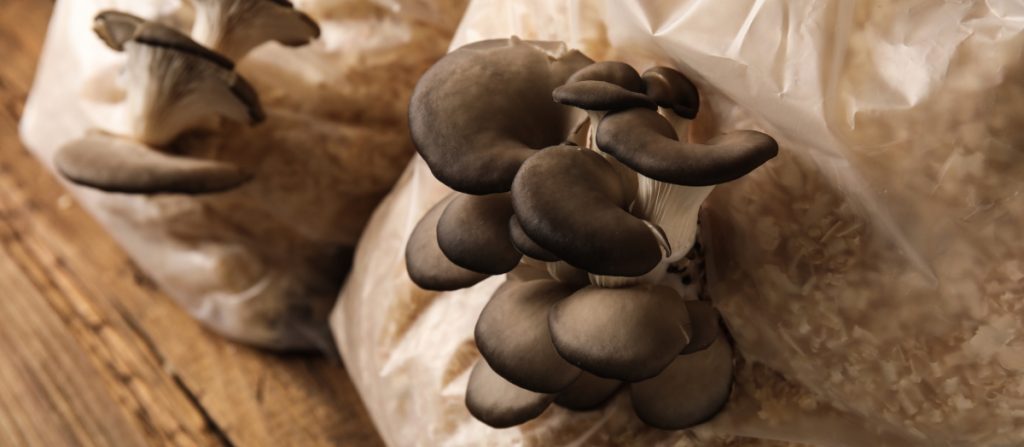As people learn more about the benefits of fresh gourmet mushrooms, they want to include them in their daily meals.
But, many varieties are not available fresh in grocery stores or supermarkets.
And, unless you have a local mushroom farmer nearby, the best way to ensure a constant supply of fresh mushrooms is to grow your own.
Fortunately, you don’t need lots of space or expensive equipment to start growing mushrooms at home.
For complete beginners, mushroom growing kits are a great option.
But once you get hooked, growing mushrooms on sawdust blocks is one of the quickest, easiest and cleanest ways to get consistent mushroom harvests.
For these reasons, it’s also the method of production used by most small to large-scale commercial mushroom growers.
In this article, we explore why you should grow mushrooms on sawdust, which sawdust to use and what a supplemented sawdust block is.
We also provide a step-by-step guide to growing mushrooms on sawdust blocks and information on the kinds of mushrooms you can grow in sawdust.
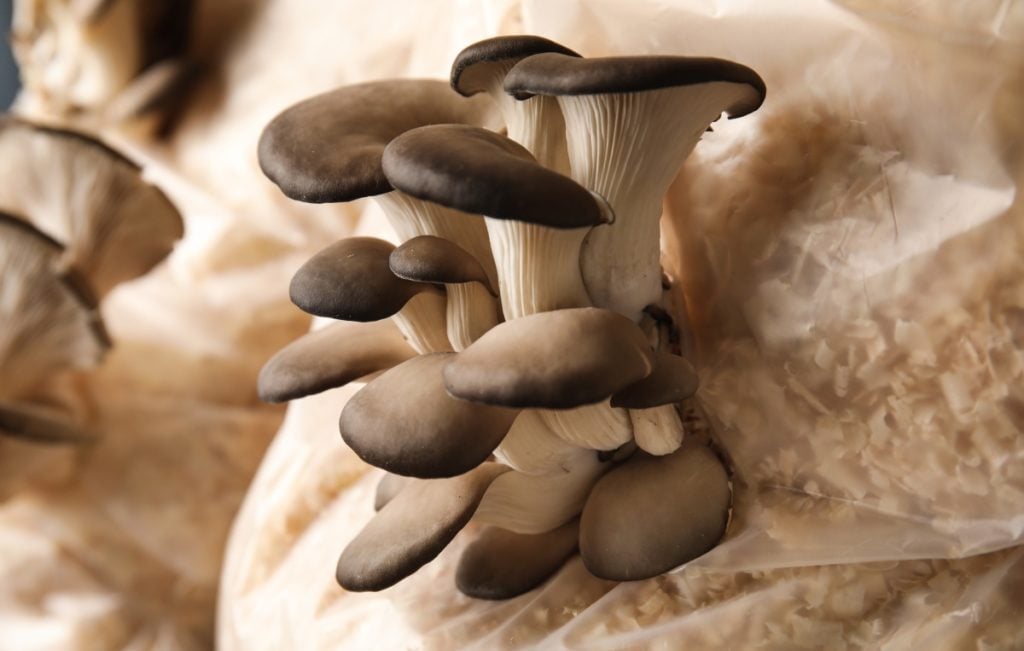
Will Mushrooms Grow in Sawdust?
Yes, wood-loving mushrooms that grow on dead and decomposing logs and stumps will grow in sawdust.
These types of mushrooms are saprotrophs. They get their nutrition from decomposing organic matter that’s high in woody, fibrous materials like lignin, cellulose and hemicellulose.
And, as sawdust is pulverized wood, it contains the same organic material as logs or stumps, just in a different form.
Sawdust is an excellent substrate for wood-loving mushrooms, but not just any sawdust.
It’s important to use the right sawdust. Otherwise, your attempts to grow mushrooms may be unsuccessful.
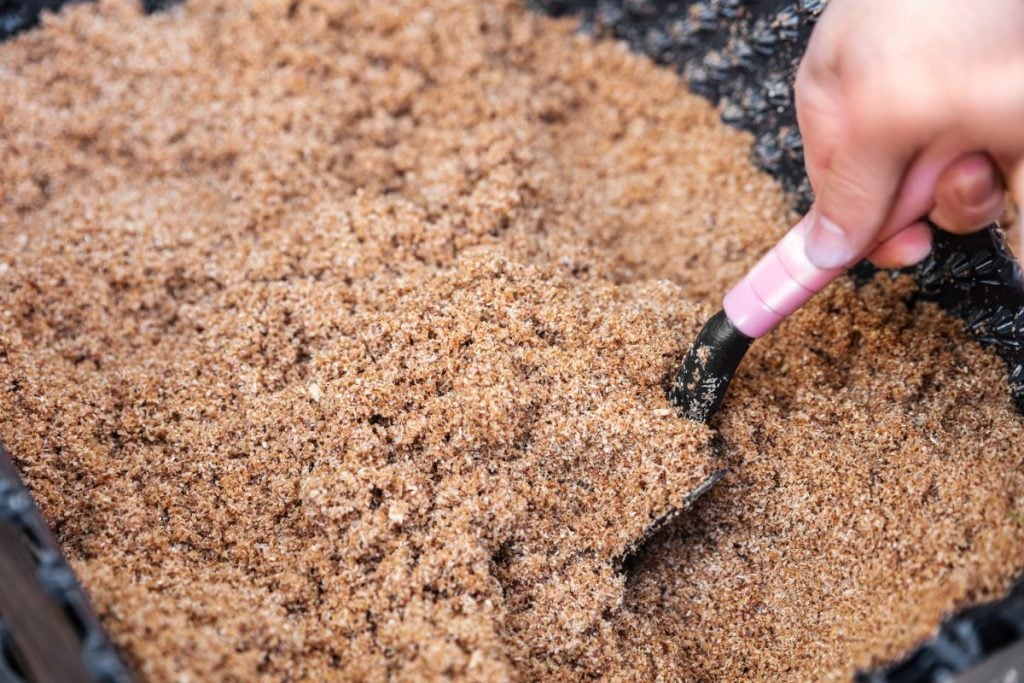
Which Types of Sawdust Can You Use to Grow Mushrooms?
Most gourmet mushrooms will only grow on sawdust from hardwood trees. But, you can also use softwood sawdust in certain instances to grow some mushroom species.
You can use a wide range of hardwoods, but some are not as easy to source and more expensive than others.
We recommend using whichever hardwood sawdust you can source locally.
You can buy hardwood sawdust, make some at home or collect sawdust from local factories and sawmills.
But, wherever you source it, make sure it’s fresh and clean and does not contain any bits of bark or leaves.
Another thing to check, if you are sourcing your sawdust from a factory, is that all the sawdust comes from untreated wood.
Mushrooms will not grow on sawdust from treated wood.
Hardwood pellets, commonly used for pellet stoves and grills, are one of the easiest ways to source sawdust for mushroom growing.
They’re ideal because they’re readily available, fairly inexpensive and easy to store.
They’re also already very clean as they’re heat treated during the production process.
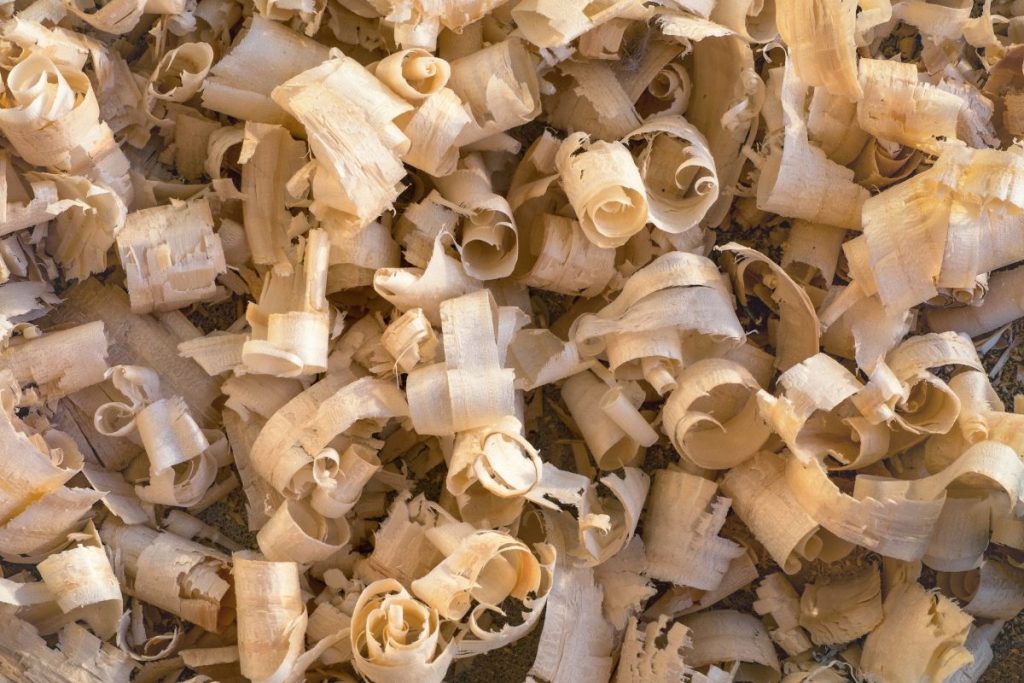
Can You Grow Mushrooms on Wood Shavings?
Yes, you can use hardwood shavings as your source of sawdust.
People often mix finer sawdust with wood shaving or fine wood chips to improve aeration in their substrate.
If your sawdust particles are too fine, they may compact, preventing airflow and creating anaerobic conditions in the middle of your sawdust block during incubation.
These conditions will prevent the mushroom mycelium from fully colonizing the substrate.
What is a Supplemented Sawdust Block?
Supplemented sawdust blocks are blocks of mushroom growing substrate made using a mixture of organic materials, not just sawdust.
Although you can grow several delicious gourmet mushrooms on plain sawdust blocks, most will do much better when grown on hardwood sawdust supplemented with nitrogen-rich materials.
Depending on the type of mushroom you’re growing, the ratio of supplement to sawdust could be anything from 10 percent to 50 percent.
Sawdust is commonly mixed with supplements like bran, alfalfa and soybean hulls to provide additional nutrition and increase yields.
Mushroom growers often have their own favorite sawdust block recipes for different types of mushrooms.
Here are some options for sawdust blocks:
Plain Hardwood Sawdust
If you don’t have access to a pressure cooker for sterilization and want to keep things simple, starting with plain hardwood sawdust is an option.
Hardwood pellets soaked in water will give you pasteurized sawdust, and the grain in your grain spawn provides some extra nutrients.
And, if using plain sawdust, try using a higher spawn rate to help boost the nutrients in the block.
A higher spawn rate will also speed up colonization, reducing the chances of contamination.
Sawdust With Wheat or Oat Bran
Many mushroom growers use wheat or oat bran as the nitrogen-rich supplement in their sawdust block recipes. They’re a popular choice because they’re inexpensive and readily available.
Small bags are available at grocery stores and supermarkets. But, a less expensive option is to buy larger quantities from animal feed stores.
When using bran, add it at a rate of between 10 and 20 percent of the dry weight of the sawdust before adding water.
Master’s Mix
Master’s Mix is a popular nutrient-rich sawdust block recipe using 50 percent sawdust + 50 percent soybean hulls.
You can often get soybean hulls from local farm supply outlets, in which case you can make your own Master’s Mix.
But, if you don’t have access to the raw ingredients, you can also buy bags of masters mix substrate online.
Experimental Mixes
When making sawdust fruiting blocks, you can have some fun and experiment with variations of the above mixes.
Or try adding different seed hulls or chaffs as supplements and see how they affect your yields.
What works best will depend on what’s available in your area and the type of mushrooms you’re growing.
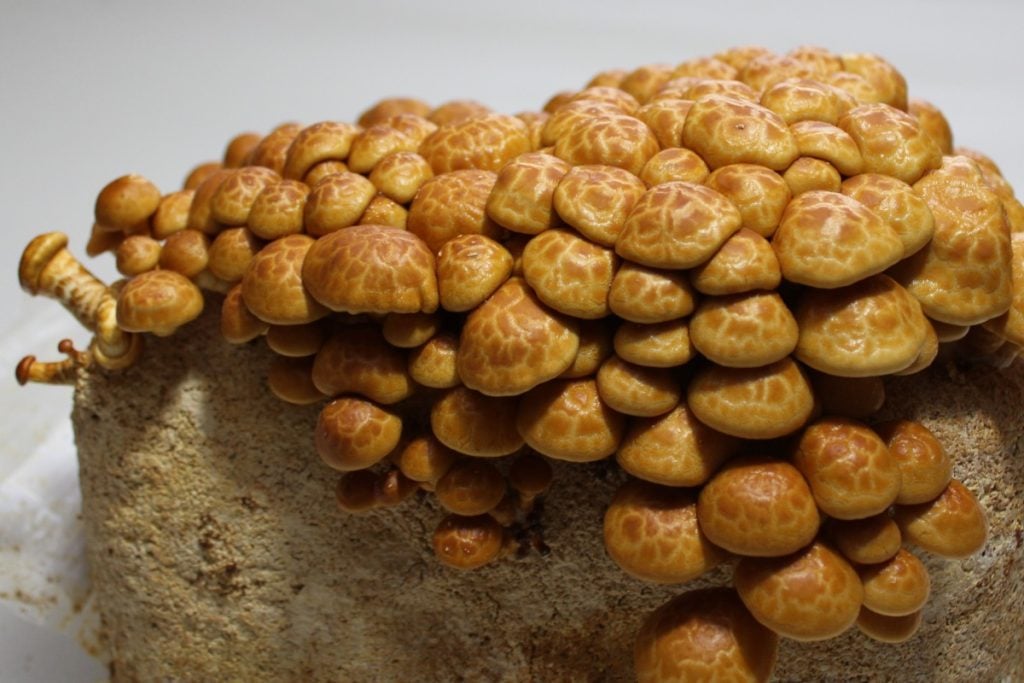
Why Grow Mushrooms on Sawdust Blocks?
You can grow a broader range of gourmet and medicinal mushrooms on sawdust blocks than on other substrates like straw, coffee grounds, coco coir or cardboard.
But this is not the only benefit of growing mushrooms on sawdust blocks.
Sawdust blocks also:
- Provide quicker yields than growing mushrooms outdoors on logs.
- Make less mess than many other substrates.
- Have lower chances of contamination.
- Provide consistent, healthy yields.
- Allow you to grow mushrooms indoors all year.
- Don’t take up much space, and you can stack them vertically.
- Provide larger yields than many other substrates when supplemented.

Step by Step Guide to Growing Mushrooms on Sawdust Blocks
Here are the steps to follow to make supplement sawdust blocks and grow your own gourmet or medicinal mushrooms.
Step 1: Gather Supplies
Before you begin gathering supplies, you need to do some research. Get an idea of what’s locally available and what works best for the type of mushrooms you want to grow.
Once you have this information, you can:
1. Order Your Mushroom Spawn

Mushroom spawn is living mushroom mycelium growing on a substrate used to transfer the mycelium to another substrate.
You can buy mushroom spawn online or from a local mushroom farmer in your area.
Mushroom spawn is available in several forms, but the three most common are sawdust spawn, grain spawn and plug spawn.
Sawdust spawn is best for outdoor use and used to inoculate large quantities of logs or mushroom growing beds.
Grain spawn has more nutrients than sawdust spawn and is perfect for inoculating a sawdust block as it allows for even distribution of spawn through the sawdust.
We don’t recommend using grain spawn in outdoor mushroom beds as birds and rodents often consume the grain, leaving you without mushrooms.

Can You Use Mushroom Plugs in Sawdust?
Mushroom spawn plugs are small hardwood dowels containing spawn used to inoculate logs to grow mushrooms outdoors.
We don’t recommend using spawn plugs to inoculate sawdust as they don’t allow the spawn to spread evenly throughout the sawdust.
2. Buy or Collect Hardwood Sawdust and Supplements
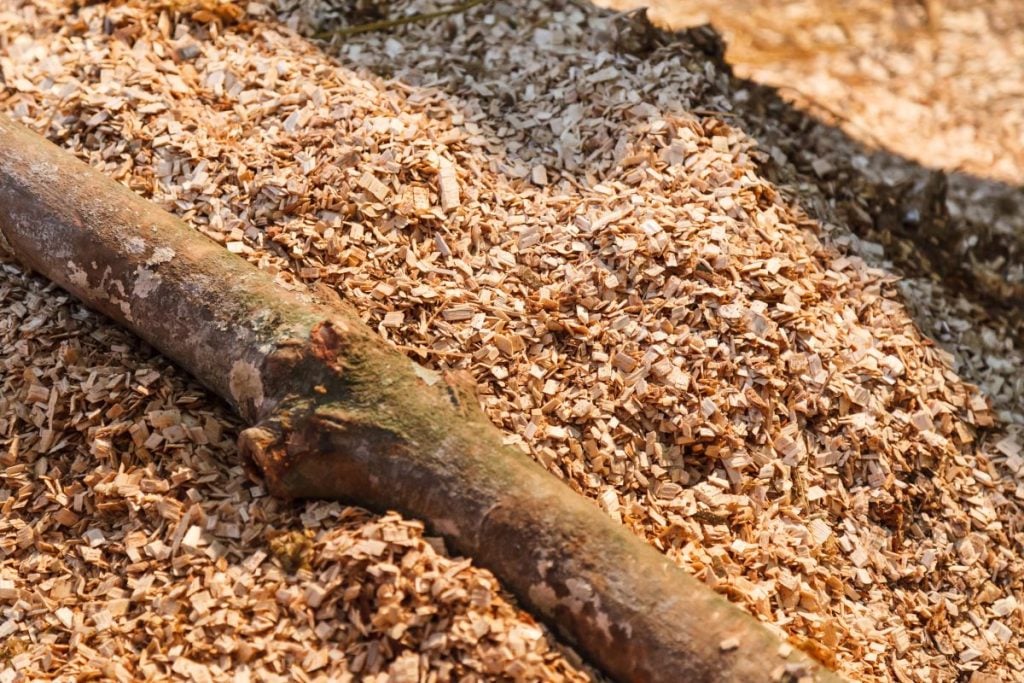
While many mushrooms will grow on a range of hardwoods, they all have favorites on which they grow best.
If their favorite hardwood sawdust is available in your area, we recommend using it as it will increase your yields.
But, if not, supplements will help, and there’s lots of information available online on the best types to use for different species of mushrooms.
Once again, we recommend using substrates and supplements that are easy to source in your area.
3. Order Mushroom Grow Bags or Source Suitable Containers
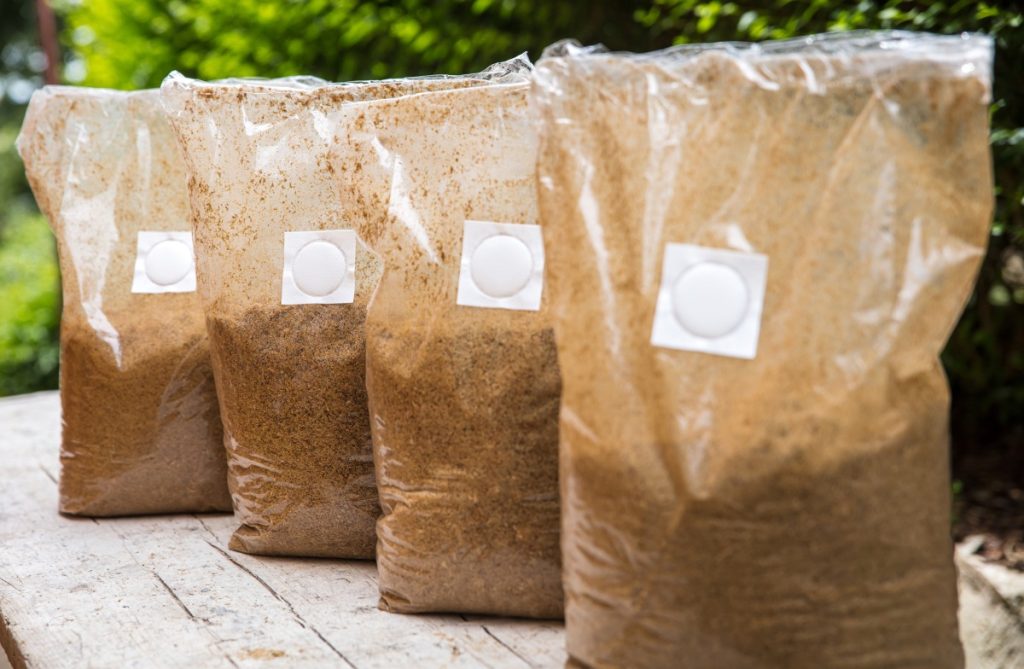
Specially designed mushroom growing bags facilitate the growing process, and many commercial mushroom growers use them.
They can withstand the high sterilization temperatures and have filter patches to allow the mycelium to breathe during colonization.
We recommend using mushroom grow bags to grow your mushrooms, and this guide focuses on these.
But, you don’t have to use grow bags. You can also use sawdust to grow mushrooms in smaller buckets, jars or other recycled plastic containers.
Sawdust is not recommended for larger 5 gallon (20 liter) buckets as its smaller particle size may create a compacted substrate with poor air exchange in the middle.
Our guide to growing mushrooms in buckets has more information and step-by-step instructions if you choose to go this route.
4. Gather Required Equipment
The wonderful thing about growing mushrooms the low-tech way is that you don’t need expensive equipment.
To make your supplemented sawdust block, you’ll need a:
- Measuring cup
- Scale
- Bucket or tote for mixing
- Pressure cooker
Step 2: Prepare Sawdust Substrate
The goal when preparing your substrate is to mix the sawdust and supplement and hydrate it evenly to 60 percent.
First, measure out your sawdust or pellets and supplement and combine them in a large tote, bucket or similar container.
Now add water at a rate of around 1.5 to 1.7 times the weight of the dry substrate and mix.
The easiest way to mix substrate is by mixing it up with your hands. Remember to wash your hands thoroughly before you begin, or consider wearing disposable gloves.
Alternatively, you can use a large spoon, sturdy plastic scoop or even a shovel if you’re mixing lots of substrate.
Here at Grocycle, we use a compost tumbler which works well for our mushroom growing business.
Before adding your mixed substrate to your bags or containers, you need to test it to ensure it has the right amount of moisture.
The easiest way to test is to pick up a handful of the mixed substrate and do a squeeze test.
Squeeze the handful of substrate lightly. If more than a drop or two of water comes out, it’s too wet, and you need to add some dry substrate to adjust it.
If no water comes out and the substrate isn’t staying together in your hand, it’s too dry, and you’ll need to add a little water.
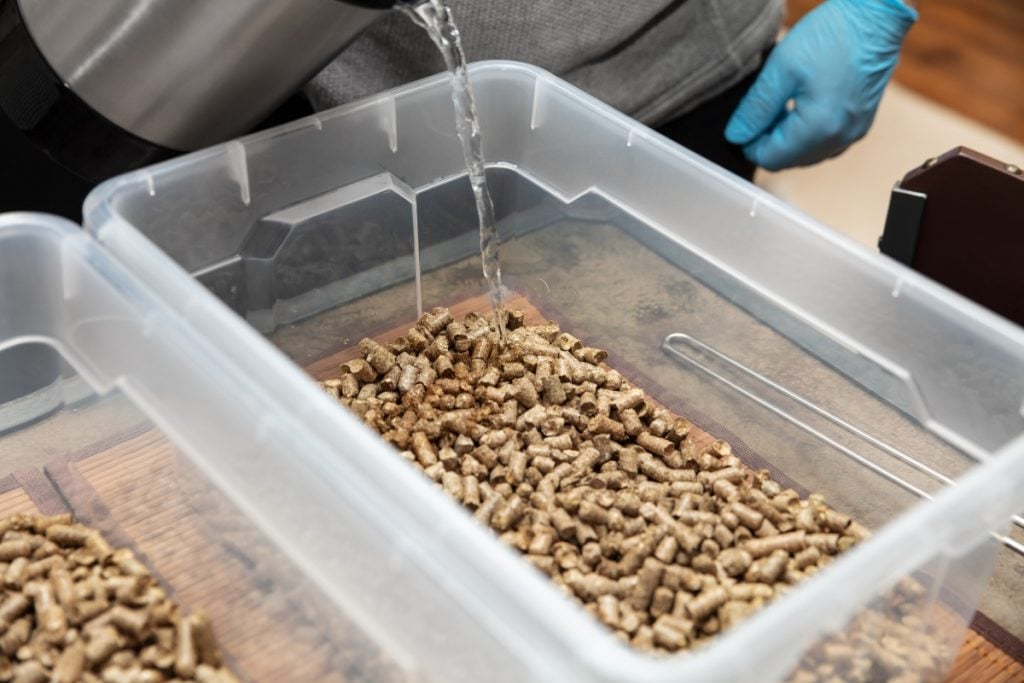
Step 3: Load Substrate Into Bags and Sterilize
When you have thoroughly mixed your substrate, and it’s suitably moist, put it into your grow bags.
Then, squeeze out as much air as possible and fold the bags according to instructions.
Now it’s necessary to sterilize your substrate in a pressure cooker to kill off unwanted contaminants like mold and bacteria.
Place the bags in a pressure cooker making sure to use jar lids or a rack of some kind to keep your grow bags from making direct contact with the bottom of the pressure cooker and burning.
Also, remember to weigh down the bags with a plate or something heavy to prevent them from blocking the pressure relief valve on the pressure cooker lid.
Pressure sterilize your bags for three hours at 15PSI.
Then turn off the heat and allow the sterilized substrate to cool in the pressure cooker for at least 8 hours.
Step 4: Inoculation
Inoculation is the process of adding mushroom grain spawn to your prepared substrate.
Before you begin, wipe down all work surfaces and clean your hands well with soap to avoid contamination.
Ensure your substrate has cooled down enough as high temperatures could kill the mycelium.
Add your mushroom spawn at the desired spawn rate to the wet substrate and mix them.
Many people choose to mix them inside the bags, but it’s easier to do this in a large box or container and then return the mixture to the bags.
It’s best to inoculate your sawdust block in front of a laminar flow hood, a workstation that helps prevent contamination.
Laminar flow hoods provide an uninterrupted steady flow of filtered clean air and are a good idea for a small-scale mushroom growing business.
Many mushroom growers build their own DIY Laminar flow hoods using a HEPA filter, fan and container or box of some sort.
But, if you’re new to mushroom growing, you can use a glove box or even just disinfectant spray to reduce the number of spores in the air around your workstation.
When the sawdust substrate and spawn are well mixed and in the bags, close the top of the bags with a rubber band or a tie of some kind, making sure it’s tightly sealed.
Step 5: Incubation
Your inoculated sawdust block is now ready for incubation.
Place the closed bags in a dark, warm area around 65 – 77°F (18 – 25°C) and leave them to incubate.
The mushroom spawn will spread from the grain spawn and grow through the substrate, feeding on the organic material you have provided.
The name given to this process is colonization.
Colonization times vary from species to species and are also affected by the spawn rate and incubation temperatures.
Now and then, check the bags for signs of contamination. You should see fine, white mycelium forming on the substrate.
But, if spots of blue, green, yellow or gray molds or patches of slimy bacteria appear, you have a contaminated block that you may need to discard.
When the mycelium has spread throughout the substrate and fully colonized the sawdust block, it’s time to place it in fruiting conditions.
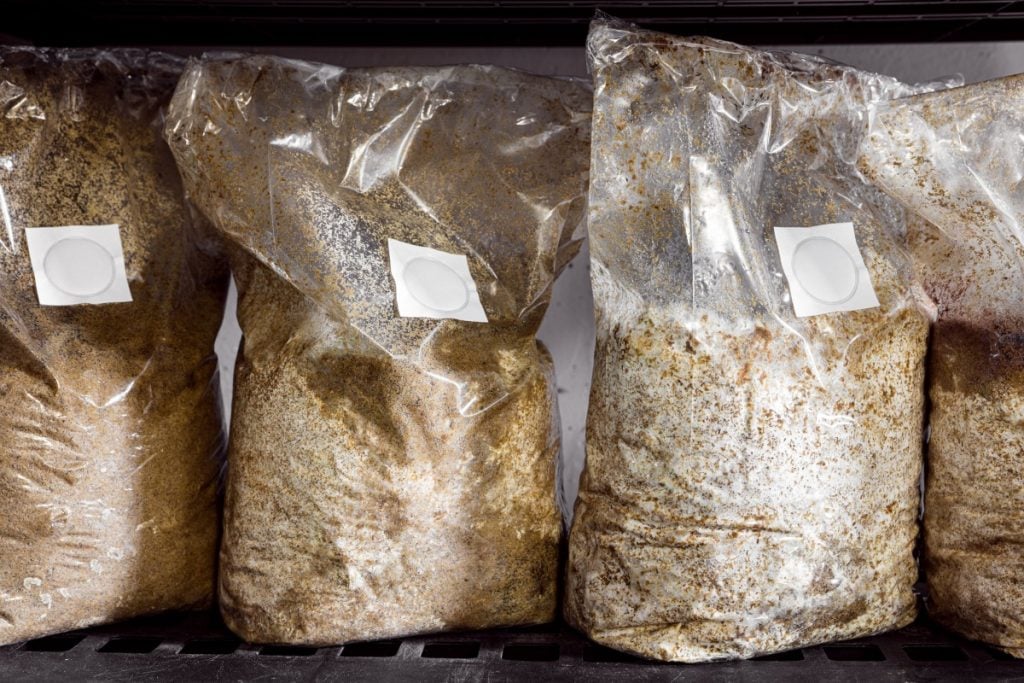
Step 6: Fruiting
This stage is the most exciting part of the process; it’s where you get to watch your mushrooms grow.
Different types of mushrooms have different requirements when it comes to ideal fruiting conditions and how you open the bag.
Depending on the type of mushroom you’re growing, fruiting conditions could be a kitchen counter or windowsill, a greenhouse or a homemade monotub or shotgun fruiting chamber, martha grow tent or larger hydroponic grow tent.
During this stage, light, airflow, humidity and temperature are important.
Our article on how to build a mushroom fruiting chamber has more information on fruiting conditions and different types of fruiting chambers.
In time, you’ll see mushroom pins forming, and shortly after, get your first flush of delicious mushrooms.
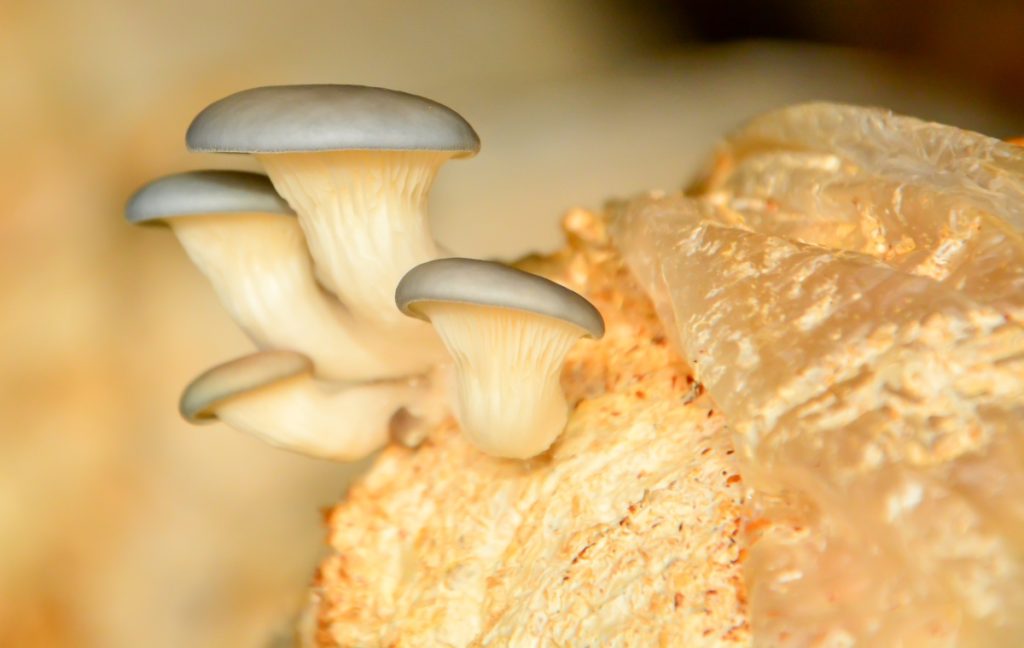
What Kind of Mushrooms Grow in Sawdust?
Many commercially produced gourmet and medicinal mushrooms are grown in supplemented sawdust blocks, including shiitake, lion’s mane, chestnut, maitake, pioppino, turkey tail and reishi.
Some mushrooms, like oyster mushrooms, are easy to grow on various substrates, including sawdust, straw, coffee grounds and cardboard.
And for fun, you could even try growing oyster mushrooms on a book.
Other species, like shiitake, are fussier and will only grow well on supplemented sawdust blocks or hardwood logs.
Below are some specifics for growing fussier wood-loving mushrooms on sawdust blocks.
Growing Shiitake Mushrooms on Sawdust Blocks
Shiitake mushrooms are popular edible mushrooms with numerous health benefits and both medicinal and culinary uses.
Shiitake need a wood-based growing medium to thrive, so you’re limited to growing them outdoors on logs or indoors on sawdust blocks.
Preferred Substrate
Shiitake prefers bran supplemented hardwood substrates and grows well on deciduous hardwoods.
They do best on oak, but you can also use maple, beech, or ironwood sawdust.
Mushroom growers commonly use a ratio of 85 percent hardwood sawdust to 15 percent wheat bran when making shiitake substrate.
Incubation
Shiitake are slow colonizers, and it takes around 3 months for them to fully colonize a sawdust block.
When the surface of the substrate becomes bumpy, and the white mycelium has turned brownish with a leathery skin, the block is ready for fruiting.
Fruiting
To fruit shiitake, remove the block from the bag and place your sawdust fruiting block in a humid area with lots of fresh air.
Shiitake enjoy temperatures of 50 – 85°F (10 – 29°C ) and 60 percent to 85 percent humidity.
Make sure to keep the block moist, and within 4 to 7 days, you should see little mushroom pins.
On average, shiitake mushrooms produce 3 to 5 flushes of fresh mushrooms when grown on sawdust.
Our guide to growing shiitake mushrooms has more information.
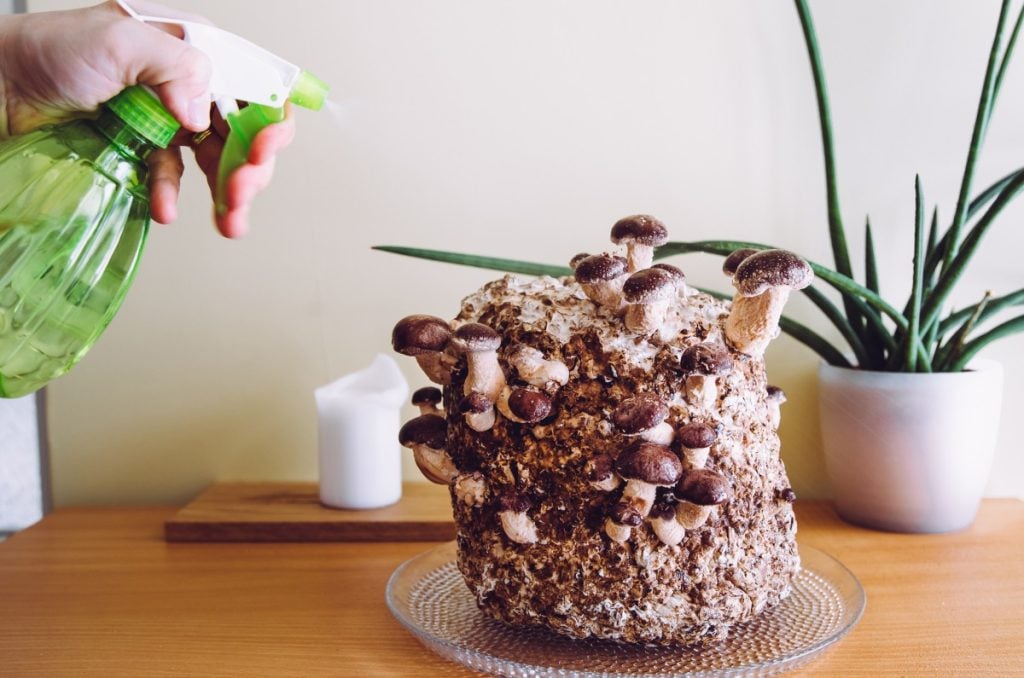
Growing Lion’s Mane Mushrooms on Sawdust Blocks
These unique wood-loving mushrooms are delicious and nutritious, with many health benefits.
Although lion’s mane mushrooms are relatively easy to grow, they have very fine mycelium, making it slightly more complicated.
Preferred Substrate
Lion’s mane grows best on hardwood sawdust blocks supplemented with wheat bran at a ratio of 10 to 20 percent.
You can use a range of hardwood sawdust to grow lion’s mane, including beech, elm, oak, maple, and birch.
Lion’s Mane mushrooms also grow well on “Master’s Mix”.
Incubation
Incubate your lion’s mane in a dark, warm area with temperatures between 68 – 75°F (20 – 24°C).
Lion’s mane mycelium is fine and wispy, and it’s sometimes difficult to know when colonization is complete.
But, a lion’s mane fruiting block should be fully colonized within 2 to 3 weeks.
And, as lion’s mane fruits easily, you’ll often start to see small mushroom pins forming in the bag.
Slice an “X” into your bag to expose the mycelium to fresh air and place the bag in a shady area with temperatures between 59 – 68°F (15 – 20°C) and 90 percent humidity.
Mist the exposed substrate with water several times a day to keep it moist and healthy.
After 2 to 3 days, you’ll start to see mushroom pins forming, and they’ll grow into full-sized mushrooms ready for harvest in around 14 days.
Our guide to growing lion’s mane mushrooms has more information.

Growing Reishi Mushrooms on Sawdust Blocks
Reishi mushrooms are wood-loving bracket fungi known for their medicinal properties. They’re intriguing, one of the easiest medicinal mushrooms to grow and produce beautiful fruiting bodies.
You can grow reishi on sawdust blocks both indoors and outdoors. Our guide to growing reishi mushrooms has more information on the different growing methods.
Preferred Substrate
Like shiitake, reishi is selective and will only grow on hardwood logs or sawdust blocks.
Oak sawdust is best if you can get it and works well when supplemented with oat or wheat bran at a ratio of 5 to 15 percent.
Incubation
Reishi is a strong colonizer and usually takes 10 to 14 days to colonize a sawdust block.
But with optimal incubation temperatures of 70 – 80°F (21 – 27°C) and 80 percent humidity, reishi could colonize the block in a week.
Fruiting
Fruiting is the longest stage, and it can take up to six weeks for reishi mushrooms to reach maturity from the time pins first appear.
Reishi grows best at room temperature around 75 – 85°F (24 – 29°C) but will tolerate a wide range of temperatures.
They need high humidity and enjoy humidity levels of 85 to 90 percent.
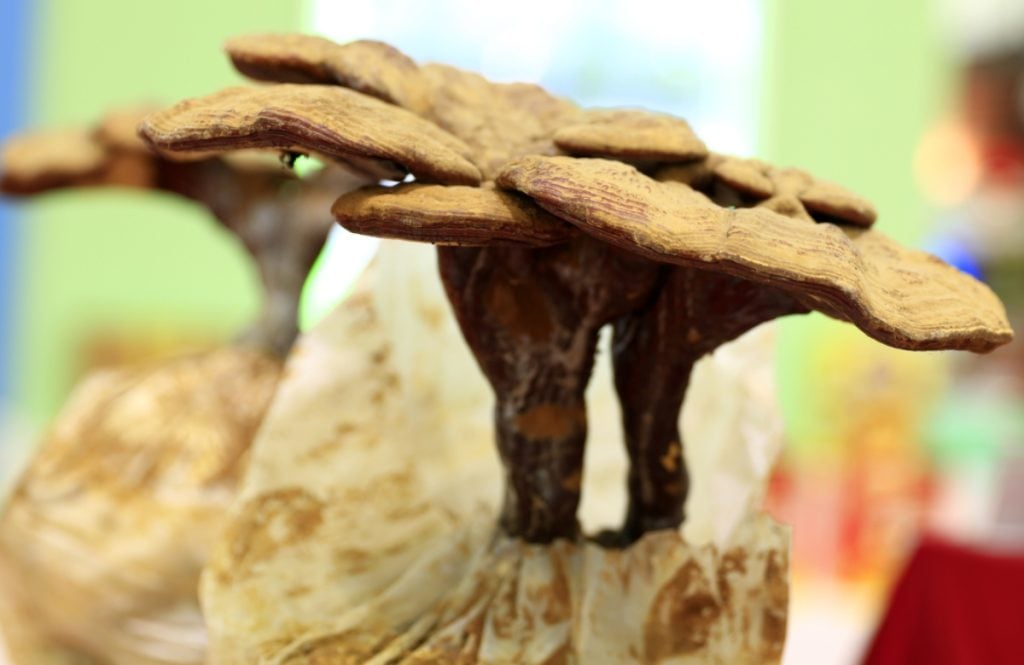
Common Issues and How to Troubleshoot Them
Learning to grow mushrooms, like any skill, takes practice, and you may encounter problems along the way.
Here are a few common issues encountered when growing mushrooms on sawdust blocks and how to fix them:
1. Green Spots Forming on the Substrate During Incubation
Green mold is Trichoderma, a fast-growing fungus that’s the most common form of mushroom contamination faced by mushroom growers.
Green mold is usually caused by poor cleaning of hands, utensils or work surfaces when inoculating the substrate.
If the spot of green mold is small and isolated, the mycelium may be able to hold it at bay, but if your bag is more than 20 percent green, it’s probably best to discard it.
To prevent mold in the future, clean all worktops and utensils thoroughly and perhaps consider building a laminar flow hood to help prevent contamination.
You can also try using a higher spawn rate to speed up colonization as this also reduces the chances of contamination.
2. Mushroom Spawn Not Colonizing the Substrate
Mushroom spawn that’s inferior, old or well-traveled may not grow.
Always use the healthiest spawn possible when growing mushrooms on sawdust blocks to increase your chances of success.
Make sure you buy your spawn from a reputable company with a good track record and preferably one that’s close by so the spawn doesn’t have to travel too far.
Use your spawn soon after it arrives, as, with time, it will weaken and the possibility of contamination increases.
You can keep mushroom spawn in the fridge to extend its life, but it becomes less viable the longer you wait.
3. Mushroom Pins Not Forming
Humidity is very important for growing mushrooms, especially during the early stages of growth.
If your substrate is too dry, the mycelium will not be able to produce fruiting bodies.
And if you let the baby mushroom pins dry out, they’ll also stop growing.
Mist your fruiting block regularly to ensure it does not dry out, and remember to be patient. Some species of mushrooms take a while to start pinning.
4. Stunted Mushrooms With Long Stems and Small Caps
Mushrooms with long spindly stems and small caps are an indication that there is not enough fresh air exchange and the CO2 levels are too high.
If you use a tote, plastic container or plastic bag as a fruiting chamber they may limit the airflow and cause this problem.
The best thing to do is remove the affected mushrooms, move the block to an area with better airflow and wait for the next flush.
5. Very Pale Mushrooms
If your mushroom caps are very pale or almost white when they should be a tan, gray or brownish color, there’s a good chance they don’t have enough light.
While mushrooms don’t need much light, indirect sunlight or artificial lighting is necessary for healthy growth and a key factor for nice cap color.
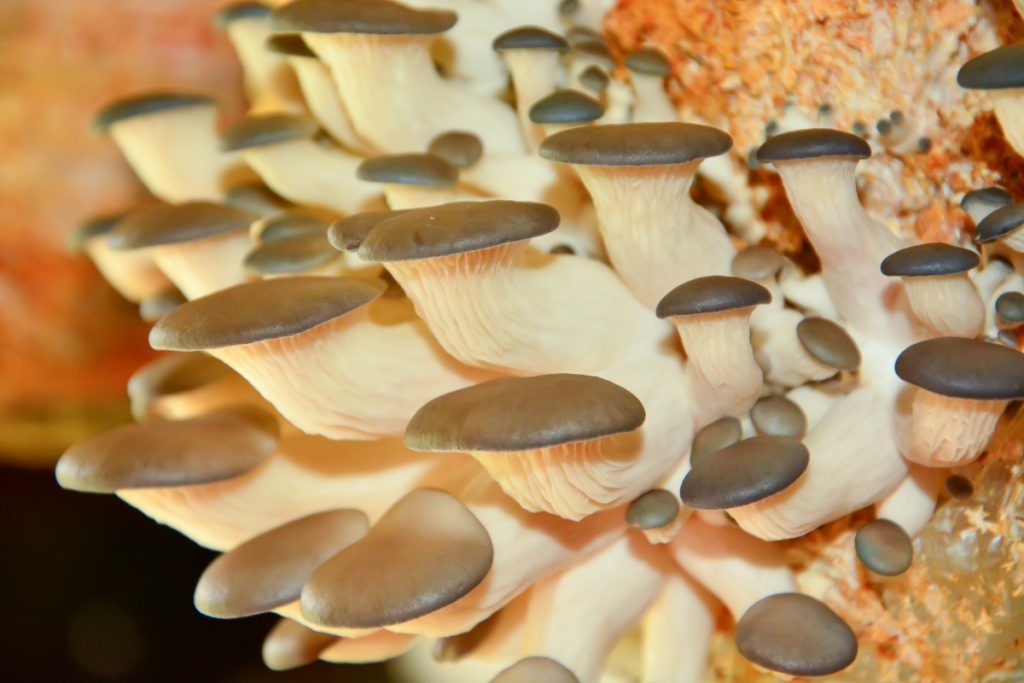
Final Thoughts
You can grow a wide range of delicious gourmet or medicinal mushrooms on sawdust blocks, and you don’t need a lot of space or specialized equipment.
Most gourmet mushrooms thrive on hardwood sawdust, and it’s best to use hardwood sawdust and supplements that are easy to source in your area.
To learn more about other ways to grow mushrooms at home, visit our Mushroom Growing Hub.
And if you’re a beginner, our introductory course on growing mushrooms at home will help you get started using simple methods and minimal equipment.
